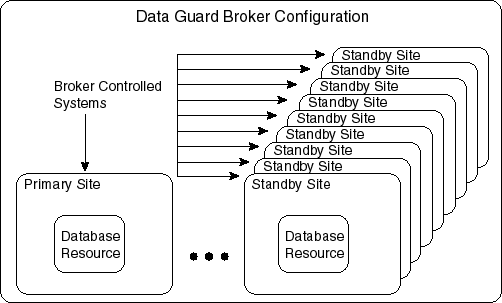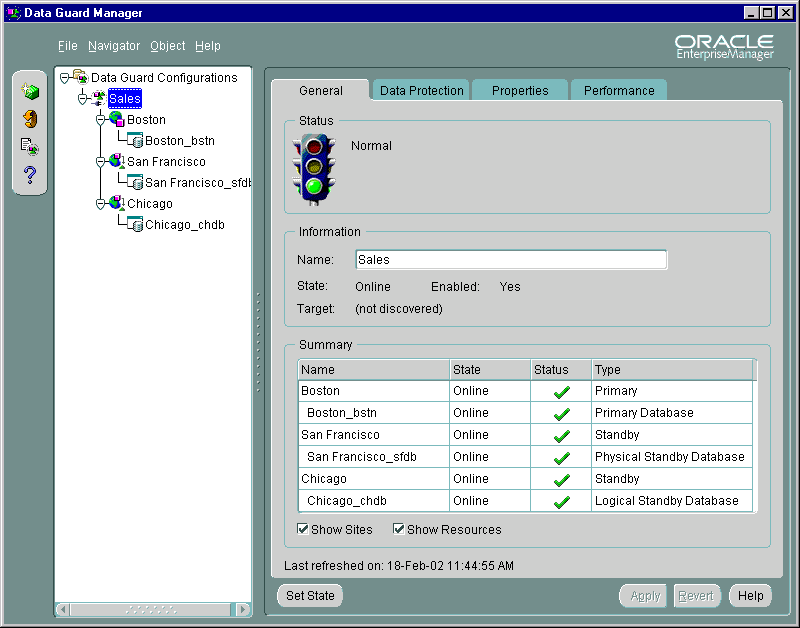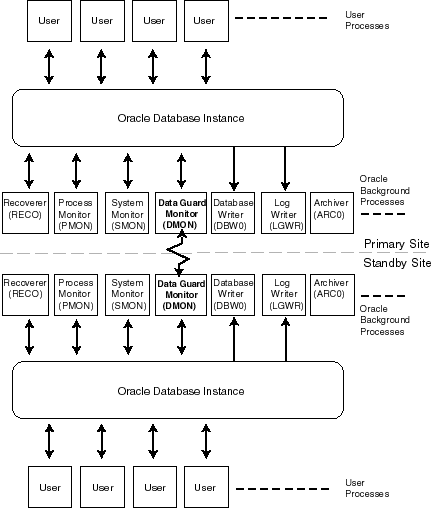Release 2 (9.2)
Part Number A96629-01
Home |
Book List |
Contents |
Index |
 Master Index |
 Feedback |
| Oracle9i Data Guard Broker Release 2 (9.2) Part Number A96629-01 |
|
This chapter describes the Oracle9i Data Guard broker, its architecture and components, and how it automates and simplifies the creation, control, and monitoring of a Data Guard configuration. The assumption is that you already have an understanding of Oracle9i Data Guard terminology and concepts.
The following sections introduce Data Guard broker terminology and concepts:
| See Also:
Oracle9i Data Guard Concepts and Administration for complete information about Oracle9i Data Guard concepts and terminology |
The Oracle9i Data Guard broker is a distributed management framework that automates and centralizes the creation, maintenance, and monitoring of Data Guard configurations. The following list describes some of the operations that the broker automates and simplifies:
You can perform all management operations locally or remotely through the broker's easy-to-use interfaces: Oracle9i Data Guard Manager, which is the broker's graphical user interface (GUI) and the Data Guard command-line interface (CLI).
The broker's easy-to-use interfaces improve usability and centralize management and monitoring of the Data Guard configuration, resulting in the following benefits:
By automating the tasks required to configure and monitor a Data Guard configuration, the broker enhances the high availability and disaster protection capabilities that are inherent in Oracle9i Data Guard. Access is possible through any client on any system in the Data Guard configuration, eliminating any single point of failure. If the primary system fails, any of the standby databases can be used for production processing.
The broker helps you to logically define and create a Data Guard configuration consisting of a primary site and a local or remote (physical or logical) standby site. If you use Data Guard Manager, it also automatically configures the communication between the sites and databases in a Data Guard configuration, which can be connected by a LAN and Oracle Network Services in the same data center, or--for maximum data protection--geographically dispersed over a WAN and connected by Oracle Network Services.
Data Guard Manager provides a wizard that automates the complex tasks involved in creating a broker configuration, including adding a new or existing standby database, and configuration of the standby control file, initialization parameter file, and datafiles. Although the CLI interface cannot automatically create a new standby database, the CLI can configure and monitor an existing standby database.
After you create a Data Guard configuration consisting of a primary and standby database, you can add up to eight new or existing, physical or logical standby databases to each Data Guard configuration. Data Guard Manager provides an Add Site wizard to guide you through the process of adding more sites and database resources. Data Guard Manager also makes all Oracle Net configuration changes necessary to support log transport services and log apply services across all sites in the configuration.
You can issue management commands from any system in the configuration to:
Only one command is required to initiate complex role changes for switchover or failover operations across all systems in the configuration. Data Guard Manager provides switchover and failover wizards that automate switchover and failover to a specified standby site in the broker configuration. Data Guard Manager prompts you to choose a new primary site from a list of viable standby sites (enabled and online, with normal status). The CLI SWITCHOVER and FAILOVER commands require you to specify only the target standby site before automatically initiating and completing the many steps in switchover or failover operations across the multiple sites in the configuration.
The broker provides built-in validation that monitors the health of all of the sites in the configuration. From any system in the configuration, you can capture diagnostic information and detect obvious and subtle problems quickly with centralized monitoring, testing, and performance tools. Both Data Guard Manager and the CLI retrieve a complete configuration view of the primary log transport queue depth and the standby log apply queue depth, in addition to data specific to physical and logical standby databases.
Also, the ability to monitor local and remote databases and respond to events is significantly enhanced by the broker's health check mechanism and Data Guard Manager's interaction with the Oracle Enterprise Manager event management system.
Use of the broker is possible for any database because the broker works transparently with applications; no application code changes are required to accommodate a configuration that you manage with the broker. However, you will need to reconnect applications after a failover or switchover occurs.
| See Also:
Oracle9i Data Guard Concepts and Administration for a complete description of the discrete steps that comprise the creation of standby databases and the other monitoring and control operations that have been automated or simplified by the broker. |
The broker simplifies the management of a Data Guard environment by performing operations against three logical objects:
The broker supports one or more Data Guard configurations, each of which contains one primary site and database, and from one to nine physical or logical standby sites and databases. A supported broker configuration consists of:
Figure 1-1 shows the hierarchy of these objects.

Text description of the illustration mgtmodel.gif
Because these objects are connected in a hierarchy, you can perform complex operations on a single object or on all objects in an entire configuration with a single mouse click or command. For example, you can bring each database resource and site in a configuration online one at a time, or bring them all online at the same time in a single step by bringing the configuration itself online.
| See also:
Chapter 2, Chapter 3, and Chapter 4 for more information about managing configuration, site, and database resource objects |
The Oracle9i Data Guard broker consists of the following components:
The Data Guard Manager graphical user interface and the Data Guard command-line interface are the broker client-side components that help you define a configuration consisting of a collection of primary and standby database sites. Section 1.5 describes these interfaces in more detail.
The Data Guard monitor is the broker server-side component that is integrated with the Oracle database server. Data Guard monitor is composed of the DMON process and Data Guard configuration files that allow you to control the objects of that configuration, modify object behavior at runtime, monitor the overall health of the configuration, and provide notification of other operational characteristics. Section 1.6 describes the Data Guard monitor in more detail.
Figure 1-2 shows these components of the broker.

Text description of the illustration odg.gif
You can use either of the broker's user interfaces to create a broker configuration and to control and monitor the configuration from any host in the configuration. The following sections describe the broker's user interfaces:
The Data Guard Manager is a graphical user interface that works with the Data Guard monitor and Oracle Enterprise Manager to automate and simplify the management of a Data Guard configuration. Because it is integrated with Oracle Enterprise Manager, Data Guard Manager allows you to manage your configuration using a familiar interface and event management system.
With Data Guard Manager, the complex operations of creating and managing standby databases are simplified through wizards provided by Data Guard Manager. Data Guard Manager includes:
In addition, it makes all Oracle Net configuration changes necessary to support log transport services and log apply services
Figure 1-3 shows the general page from the Oracle9i Data Guard Manager main window.

Text description of the illustration genconfig.gif
The Data Guard command-line interface (CLI) allows you to control and monitor a Data Guard configuration from the CLI prompt or within scripts. You can perform most of the activities required to manage and monitor the objects in the configuration using the CLI.
The following example lists the available commands:
DGMGRL> HELP The following commands are available: quit exit show See "help show" for syntax enable See "help enable" for syntax disable See "help disable" for syntax help [<command>] connect <user>/<password> [@<connect>] alter See "help alter" for syntax create See "help create" for syntax remove See "help remove" for syntax failover shutdown startup switchover
This guide provides examples and reference information for the Data Guard command-line interface.
| See Also:
Chapter 7 for complete reference information for the Data Guard command-line interface |
The configuration, control, and monitoring functions of the broker are implemented by server-side software and configuration files that are maintained on each site that the broker manages. The software is called the Data Guard monitor.
The following sections describe how the Data Guard monitor interacts with the Oracle server and with remote Data Guard monitors to manage the sites in a broker configuration.
The Data Guard monitor process (DMON) is an Oracle background process that runs on every site that is managed by the broker. When you start the Data Guard monitor, a DMON process is created.
When you use Data Guard Manager or the CLI to manage an object, the DMON process is the server-side component that interacts with the local instance and the DMON processes running on other sites to perform the requested function. The DMON process is also responsible for monitoring the health of the broker configuration and for ensuring that every site has a consistent copy of the binary configuration files in which the DMON process stores its configuration data.
| See Also:
Oracle9i Database Concepts for more information about the memory structures and processes that are used with an Oracle database instance |
Figure 1-4 shows the DMON process among several background processes that perform maintenance work for the Oracle database server.

Text description of the illustration dmon.gif
The zigzag arrow in the center of Figure 1-4 represents the two-way Oracle Net communication channel that exists between the DMON processes on sites in the same broker configuration.
This two-way communication channel is used to pass requests between sites, and to monitor the health of all of the sites in the broker configuration.
The broker's DMON process maintains persistent configuration data about all objects in the broker configuration in a binary configuration file. A copy of this file is maintained by the DMON process on each of the sites that belong to the broker configuration. Changes to this file are made by the DMON process for all copies.
This configuration file contains entries that describe the states and properties of the objects in the configuration. For example, the file records the sites and databases that are part of the configuration, the roles and properties of each of the databases, and the state of each of the objects of the configuration.
The configuration data is managed transparently by the DMON process to ensure that the configuration information is kept consistent across all of the sites. The broker uses the data in the configuration file to configure and start the site and database resource objects, control each object's behavior, and provide information to the CLI and Data Guard Manager. (See Section 4.3.2 for more information.)
Whenever you add site or database resource objects to a broker configuration, or make a change to an existing object's properties, each DMON process records the new information in its copy of the configuration file.
Two copies of the file are maintained per site so as to always have a record of the last known valid state of the configuration. When the database instance is started, the configuration files are named automatically using a default name that is operating-system specific. You can override this default name on any given site by setting the following initialization parameters for that site:
DG_BROKER_CONFIG_FILE1DG_BROKER_CONFIG_FILE2
You can also change the configuration file names dynamically by issuing the ALTER SYSTEM SQL statement. However, you cannot alter these parameters when the DMON process is running. To change the names of these configuration files on a given site, perform the following steps:
DISABLE command or the Disable operation in Data Guard Manager. See Section 2.4.SQL> ALTER SYSTEM SET DG_BROKER_START=FALSE;
SQL> ALTER SYSTEM SET DG_BROKER_CONFIG_FILE1=filespec1SQL> ALTER SYSTEM SET DG_BROKER_CONFIG_FILE2=filespec2
filespec1 and filespec2, respectively, at the operating system level to avoid losing the existing broker configuration information.SQL> ALTER SYSTEM SET DG_BROKER_START=TRUE;
ENABLE command or the Enable operation in Data Guard Manager.Associated with each site and database resource object are various properties that the DMON process uses to control the object's behavior. The properties are recorded in the configuration file as a part of the object's definition that is stored there. In particular, many database resource properties are used to control database initialization parameters related to the Data Guard environment.
To ensure that the broker can update the values of parameters in both the database instance itself and in the configuration file, you must use a persistent server initialization parameter file (SPFILE) to control static and dynamic initialization parameters. The use of a SPFILE gives the broker a mechanism that allows it to reconcile property values selected by the DBA when using the broker with any related initialization parameter values recorded in the SPFILE.
Thus, when you set definitions or values for database properties in the broker configuration, the broker records the change in the configuration file and also propagates the changes to all of the sites in the Data Guard configuration.
| See Also:
Section 4.3.2 for more information. |
Oracle9i Data Guard and the broker (including the CLI) are included with the Enterprise Edition or Personal Edition of the Oracle9i database server software.
The Oracle9i Data Guard Manager graphical user interface is included with the Oracle Enterprise Manager software.
To use the broker and the CLI, you must install the Oracle9i Enterprise Edition or Personal Edition database server on each site where you plan to manage broker configurations.
If you plan to use the Oracle9i Data Guard Manager graphical user interface to manage broker configurations, you must install it with the Oracle Enterprise Manager software.
If you are currently running an Oracle9i Data Guard Release 1 (9.0.1) configuration, you must upgrade to Oracle9i Release 2 (9.2) and recreate the broker configuration, as follows:
| See Also:
Oracle9i Database Migration if you are upgrading from Oracle8i Data Guard to Oracle9i Data Guard |
The following conditions must be true before you can use the broker:
DG_BROKER_START parameter must be set to TRUE. See Section 2.2 for more information. (Data Guard Manager sets this parameter for you automatically.)DG_BROKER_CONFIG_FILEn initialization parameter. See Section 1.6.2 for more information.COMPATIBLE initialization parameter to 9.0.0.0.0 or higher for both the primary and standby databases.| See Also:
Section 2.2 for more information about preparing and starting Oracle9i Data Guard. See Oracle9i Data Guard Concepts and Administration for more information about setting up the network files. |
|
 Copyright © 2000, 2002 Oracle Corporation. All Rights Reserved. |
|